Knights on miniatures from medieval manuscripts (part one)
but it was already in the centuries that were before us. ”
(Book of Ecclesiastes 1: 10)
About how people lived in the Middle Ages, what they wore, what they ate, how they fought, various sources of information help historians to find out. This archaeological finds and texts of various manuscripts, and monuments in churches and cathedrals. But of particular value for us are the colored, hand-painted miniatures that are in the old books of that distant era. After all, they with great accuracy transmit the world around the artist, and therefore become for us a kind of "time machine." And in European libraries, museums and private collections thousands of such manuscripts are kept. And most of them are illustrated with color drawings, as people of that era loved images and bright colors. Some of these manuscripts contain several hundreds of such images, and each of them tells some of its own. history: shows people at work, on holiday, at the dinner table or on the battlefield. In this case, they explain something, but something remains a mystery, which they cannot explain to us. So what about many things, looking at them, we still have only to guess. For example, the famous “Macieva’s Bible”, filled with a set of simply beautiful colored miniatures. However, it is enough to consider them carefully to find them in them a lot of interesting and ... even mysterious!
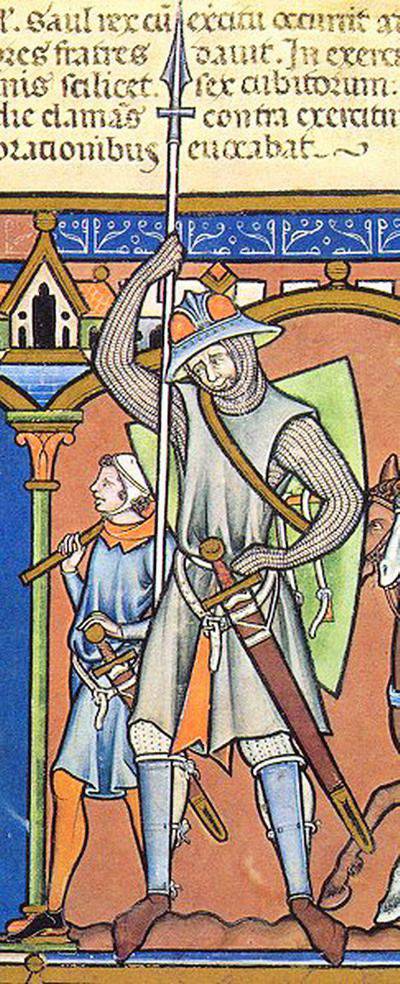
This miniature from the Bible of Matsiyevsky shows a warrior (in this case, none other than the giant Goliath!) Wearing a helmet “cap de fer” (or “cap”), surko, worn over chain mail, quilted kneecaps and lamellar knives, with calf ties.
We start the story about it with the fact that this richly illustrated book is stored in the New York Library of Pierpont Morgan (catalog code is Ms M. 638), which is why it is often called the “Morgan Bible” abroad. In our country, she appears under the title "The Bible of Macius" - because she was in the collection of Bernard Macieusky, Bishop of Krakow and Cardinal Polsky before the 1608 year. But it is also called the Bible of Louis IX or the "Bible of the Crusader." This is due to the fact that the manuscript was created by order of Louis X. of France of France, who went down in history as the organizer and leader of two crusades, the Seventh and the Eighth. The creation of this book itself refers to 1240 - 1250's.
But what is her so great value? And the fact that it is filled with beautiful colorful miniatures, showing us the life of contemporaries of that era. So this particular manuscript is considered to be one of the main pictorial sources in the field of historical reconstruction of the Middle Ages, and first of all its weapons and costumes. However, let's see: are the events described in it biblical? Yes, of course, and many of them happened “long before the Flood”! But all the people in her illustrations are depicted in the clothes of the thirteenth century! The artist who painted them did not have historical thinking, that is, that before everything could have been a little different, he had no idea! And this must be remembered by all who consider medieval miniatures. There are no stories in the development of them and there can not be! What they depict is a photocopy of what surrounded their creator, even when he would like to illustrate the time before him that was far from him for many centuries!
However, for us, nothing wrong with that, on the contrary. Moreover, with a minimal amount of text, this magnificent code contains entire 283 illustrations for the first books of the Bible, starting from the Creation to the reign of David, that is, to the First Book of Kingdoms. Compositionally on the page are usually four rectangles with different scenes from the Bible. Initially, there was no text in the book at all, but later, approximately in 100 years (in the middle of the XIV century), brief descriptions of what was happening in Latin were added in the margin. It is believed that this was done in Naples on the initiative of Charles of Anjou.
In 1604, Cardinal Macieuski handed over the manuscript to the papal delegation, which was on a visit to the Persian Shah Abbas I, who received the precious book as a gift. Shah ordered a Persian translation of most Latin explanatory notes. So the Persian text also appeared in this book. However, the Shah, being a true tyrant, ordered three sheets to be removed from the book. And all because the illustrations on them showed Absalom having revolted against his father David. Well, and, of course, the shah found a similar example for his sons quite unsuitable. Moreover, later he ordered them to be blinded and killed altogether, fearing that they would become the favorites of the people and depose him from the throne! But the truth is told by those who claim that the manuscripts do not burn! All three of these deleted pages, fortunately, survived all the hardships of time and are in Paris today.
Later, the Judeo-Persian (made in the Persian language by the Hebrew alphabet) inscriptions were also added here. Well, in the end, a certain Thomas Philips bought it from a Greek named Jonas Atanasius, and his descendants sold it to John Pierpont Morgan, a famous American billionaire and collector of antiquities. That is because what adventures she had to go through in order to bring to us all her beauty and ... all her edification!
As it is known, the Bible is a rather ambiguous book, for a long time the Catholic Church forbade a long time to read it to ordinary believers. However, this did not concern the crowned persons, and even more so, for them it was possible to rewrite the Bible ... as the customer apparently wanted! For example, in the cycles of miniatures of the Bible of Macieus, for some reason, the lives of the kings of Saul and David are highlighted. Unique to the lists of the Old Testament V - XIII centuries. and the fact that the Bible of Morgan contains 21 is a big battle scene, written in all its cruel details! We see helmets and chain armor cut with swords and axes, horsemen plunging daggers into the eye of the enemy, severed and bleeding parts of bodies. Probably, Saint Louis, when he looked at these miniatures, saw all this before his eyes and ... maybe remembered how he commanded his crusade. Who knows? However, the most important thing is that the one who drew all this drew from the business. In addition, it should be noted that with all its naturalism, the scenes in the Bible of Macieusky are arranged so as to highlight the cause and effect of righteous and unrighteous deeds, that is, a clever and well-read man worked on it. For example: first we see Cain, who kills Abel, and Lamech, who kills Cain, after which the turning of the page leads us to Noah, who built the ark and thus saved his family from the flood. Well, Abraham, preparing to lower the sword to Isaac, is shown before he defeated the Elamites and saved Lot's family.
Such deviations from the chronology of the narrative of the Old Testament could be dictated by only one circumstance, namely, the desire of the author to strengthen the didactic, that is, instructive, orientation of the text. So, if in the lower right corner of the page there are dark and sullen sodomites, then in the upper left corner it is shown that their sin led to the destruction of Sodom. And here we see Lot's wife turned into a pillar of salt. But the picture of how Abraham asked for God's mercy for Sodom is not here. And this leads to the conclusion that such tolerance in relation to the Sodom of sin, the author of the manuscript was clearly inaccessible.
Similarly, the image of Abimelech, who kills his brothers, is placed opposite the image of Ifaha, sacrificing his daughter. That is, it is obvious that such an arrangement of scenes should have helped the viewer understand the big difference between righteous and unjust murder and set them on the right path.
Well, now let's take a close look at at least some of her illustrations, because then we can see just unique historical details, depicted very, very reliably, because the people of that time drew these illustrations. First of all, the scenes themselves - after all, there is nothing in them. Here and plowing, and the construction of walls with the help of a primitive crane with a lifting mechanism of the "squirrel wheel" type, pictures of the hunt and even a "bed scene". However, the first thing that catches the eye is the surcoe, which the knights of the time wore over the chain mail, here most often not at all white, but red, orange, blue, green, gray and brown. And the color of horsecloths on horses of riders with a color surcoe almost never coincides! Here, for example, is the scene where the Israelites are chasing the Midianites, and on which to the left are four trumpeter horsemen. They do not have helmets, only hauberks with gloves woven to their sleeves, wrapping them in mail from head to toe. So pay attention: the first surco is blue, but with a red lining, the horse blanket is white, and its lining is for some reason blue. On the other two trumpeters, there is no surcoat at all, whereas the last one in this four surco is red on top, and inside is green, and there is no blanket on the horse at all!
But on one of the miniatures of a warrior dressed in a hauberk, surcoat without sleeves of orange color, but a blue caftan with wide sleeves to elbows peeks out from under it. That is, it turns out that some of them were wearing two surcoats at once or two cotts one under the other?
The peasants, as it should be, are all in caps, like modern babies, wide bra bottom pants and narrow upper stockings pants — highway. On one of the knights on his head, a cap is clearly visible, over which a servilier is wearing a metal helmet, while the mail hood is folded on his back! We see exactly the same blue servilera on the head of the kneeling Abraham, whom Melchizedek blesses, and his chainmail hood is likewise laid back on his back! Conical helmets are usually just painted and that's it. But the coloring of the helmets “Cap de Fer” looks very original: only the dome is painted on miniatures from the Bible of Matsiyevsky, but the margins and the transverse metal stripe connecting the parts of the dome have the color of metal. On helmets such as tophelm for many characters, we see golden crowns denoting their rank, while the helmets themselves are gilded with someone, and just painted with someone. And for some reason, besides the crowns, there are no other ornaments on them.
Interestingly, for some reason, some of the knights have shields that are round (perhaps the artist identified the enemies of Christianity as the Saracens, although the helmet is all the same), while most others, as a rule, have the shape of an iron. There are stamp images on them, but they are amazingly small, although in theory there should be much more of them. However, on some shields riders can see crosses, there is obviously a heraldic lion, one of the Midianites has an eagle or a raven on the shield, but the infantrymen have patterns on the shields!
The armor of many of the foot soldiers is clearly quilted — that is, the very acetons and gambizons, while they have a scalloped hem and often the same sleeves. Warriors wear chain mail over their heads, while their hoods are clearly attached to chain mail. Helmets infantrymen simple and painted entirely, and in sufficiently contrasting colors. For example, one soldier in a red quilted armor has a blue helmet! Here, involuntarily, I recall the historic Soviet movie 1938 of the year “Alexander Nevsky”, where the knights of the Crusaders are distinguished by simply stunning imagination with helmet ornaments and where it happens just in 1242 year!
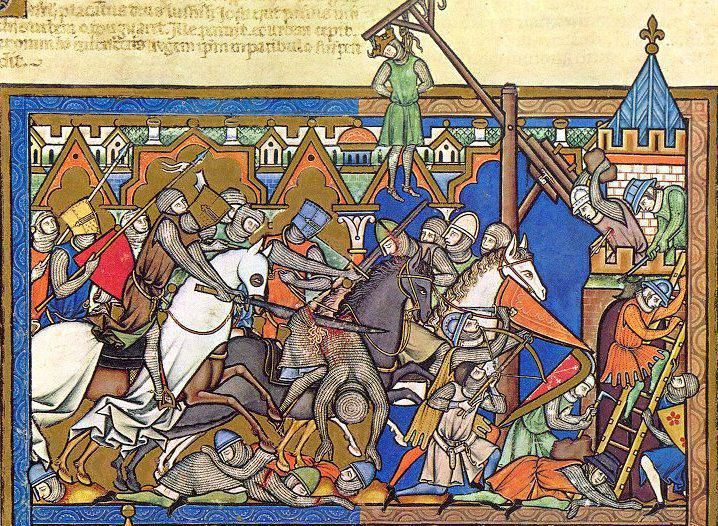
The first who draws attention to this miniature is a rider in a brown surcoat, and on a horse in a white ass. With both hands, he holds some strange weapon with a "spit" blade, more resembling a halberd coase (or short glaive) with a shortened shaft, with which he cuts the enemy retreating in literally in half. This drawing doesn’t take realism, although compositionally it is terrible: a warrior on a horse in a white blanket is closer to the viewer than the one that jumps on a black horse. And, nevertheless, he somehow manages to strike this warrior on the right, although, judging by his position in space, he must be on his left!
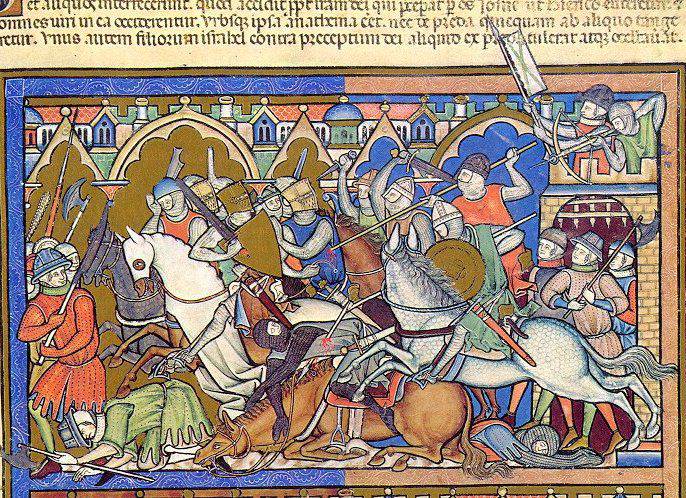
But on this miniature from the Bible of Macieus we immediately see two methods of using a spear: kushirovanie, that is, when the spear is clamped under the arm, and the ancient way in which the warrior holds the spear with both hands.
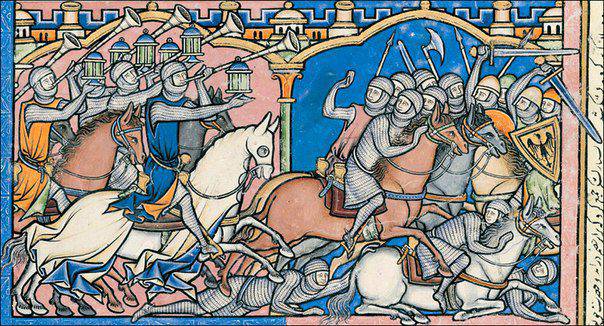
The Israelites are chasing the Midianites (miniature from the Bible of Macieus).
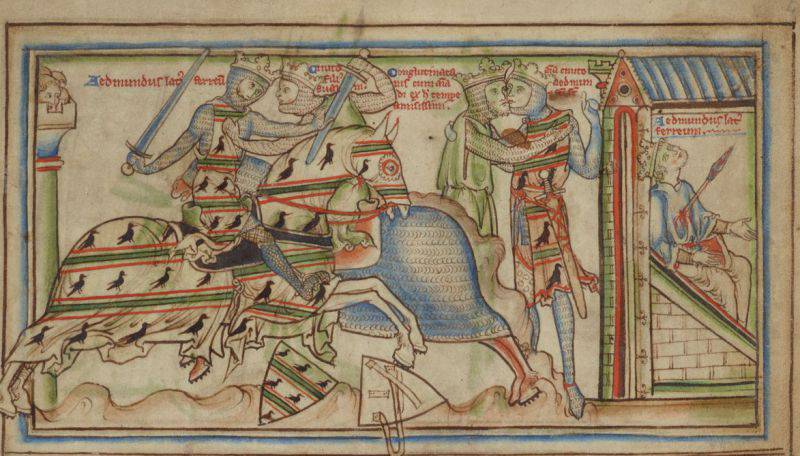
Bout Knut the Great and Edmund Zheleznobokogo, after which they made peace, and Edmund was treacherously murdered. Miniature from the Bible Confessor by Matthew of Paris. About 1250 (Parker Library, Body of Christ College, Cambridge)
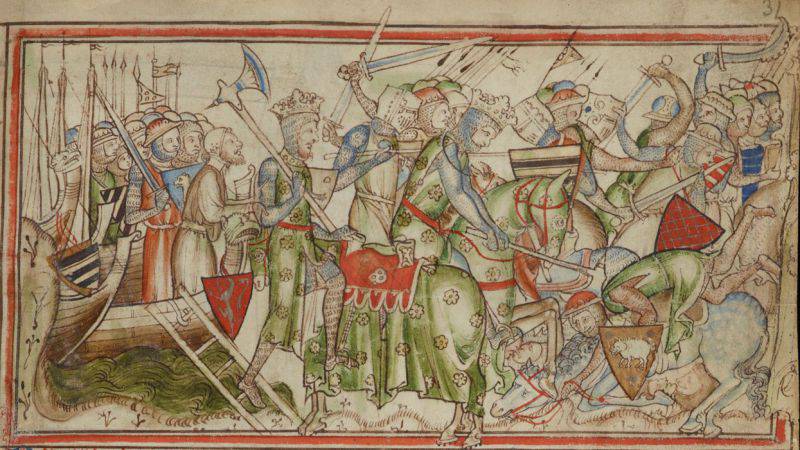
The landing of Harald Hardrad’s army and the defeat of Northumberland’s army. Miniature from "Life of sv. Edward the Confessor Matthew of Paris. About 1250 (Parker Library, Body of Christ College, Cambridge)[/ Center]

Enlarged fragment of a miniature from "Life of sv. Edward the Confessor.
Information